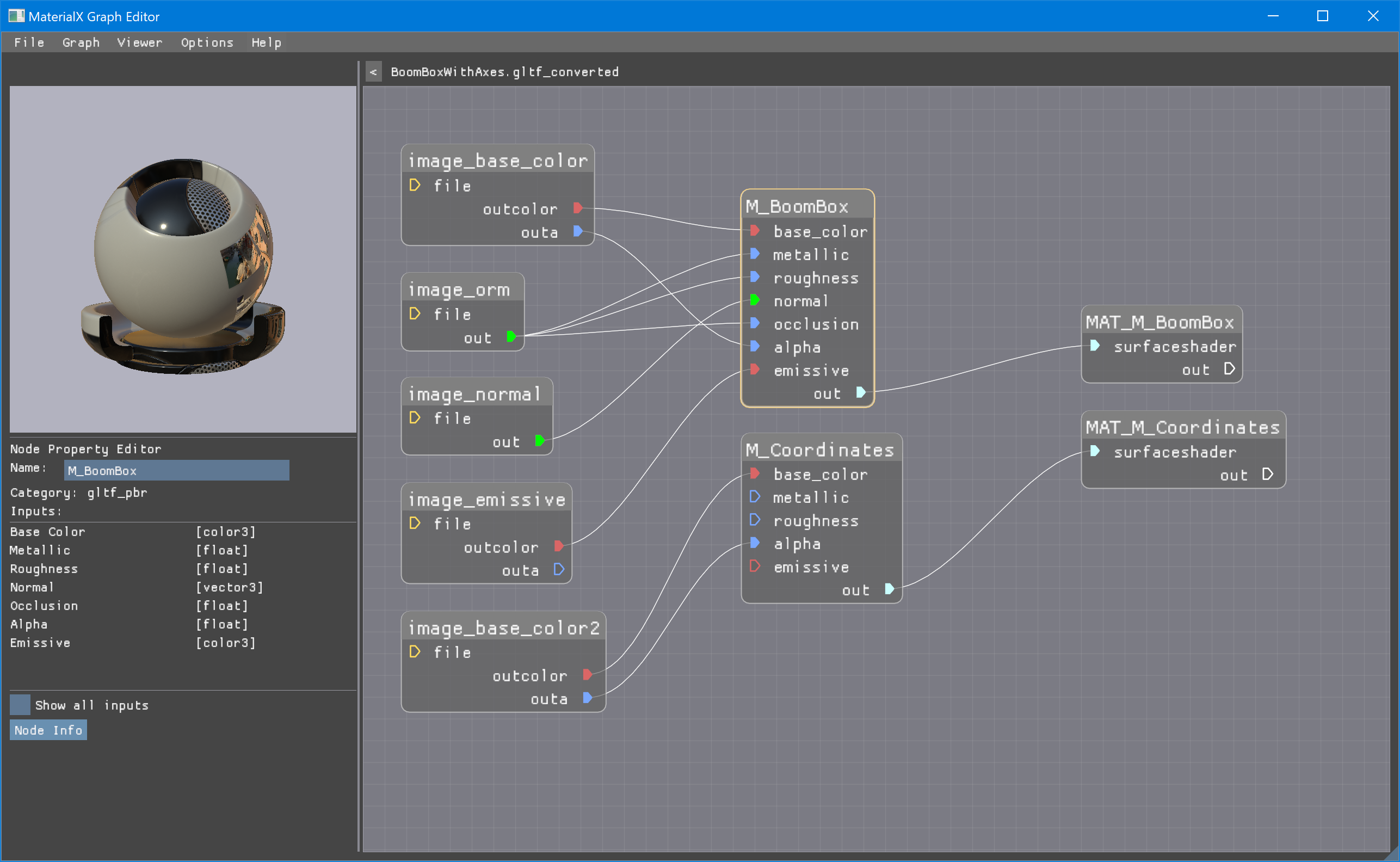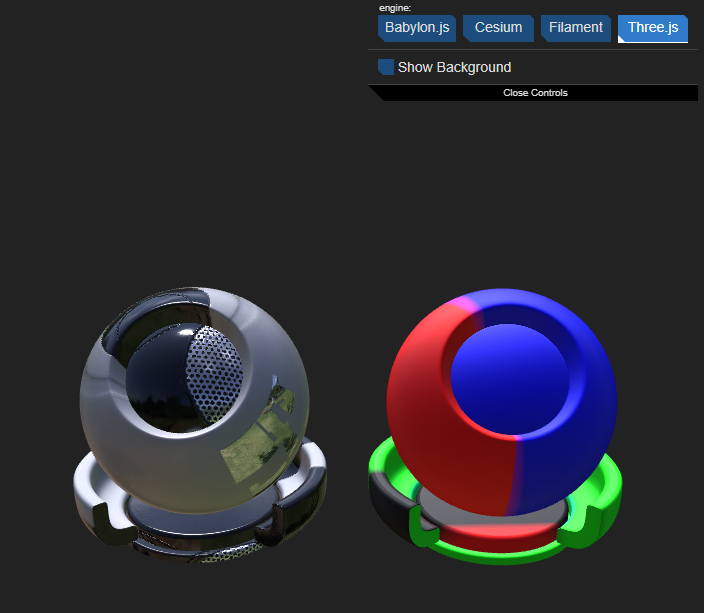Bidirectional conversion utilities for MaterialX and glTF
Project description
materialxgltf
Contents
Introduction
This package supports the bi-directional translation between MaterialX materials and glTF materials. The minimum version of MaterialX required is 1.38 8 and the target glTF version is 2.0.1.
See the home page for this project.
Below is an example of converting the "Damaged Helmet" asset (found in the glTF Sample Model repository) to MaterialX and previewing.
The functionality found here is equivalent to the C++ module available in this repository. Note that additional documentation can be found on that site.
Installation
The minimum version of Python is assumed to be 3.9.
The package hosted on PyPi can be installed using pip:
pip install materialxgltf
or the source repository can be cloned and the package built from the command line:
py -m build
This will build a distribution folder called dist which contains
a zip file which can be installed using:
pip --install <name of zip>
Requirements
Requires the installation of the following packages:
materialxversion 1.38.8 or higher: For editing MaterialX documents.pygltflib: For conversion fromglTFtoglbincluding packaging dependent geometry and image resources.
Documentation
For more detailed information about the workflow this package supports, please refer to this documentation.
For API usage, refer to this documentation.
Usage
<script type="module" src="https://unpkg.com/@google/model-viewer/dist/model-viewer.js"></script>The following shows is a set of progressive examples to convert from a glTF file to MaterialX and then to a new glTF file for "shader ball" preview of extracted materials.
Note that the sample data is included as part of the package for convenience.
The sample input file is the "BoomBox with Axes" file from the glTF sample repository found here.

This is converted from glTF to a MaterialX document which can be previewed / modified using an integration which supports MaterialX. Here the file is loaded into the "MaterialX Graph Editor" which comes with MaterialX releases.
The converted materials are then used to create a new glTF file using sample "shaderball" data with each material found assigned to different instances of the "shaderball"
Interactive Example
A Jupyter notebook which performs the same steps is available here.
This or any other notebook can be used if the user wishes to test the package in an interactive environment.
Import the package
import materialxgltf.core as core
Check Available Sample Data
import pkg_resources
directory_name = "data"
files = pkg_resources.resource_listdir('materialxgltf', directory_name)
for file in files:
print('Data file: ', file)
Convert from glTF to MaterialX
import pkg_resources
import MaterialX as mx
gltfFileName = pkg_resources.resource_filename('materialxgltf', 'data/BoomBoxWithAxes.gltf')
print(gltfFileName)
# Instantiate a the reader class. Read in sample glTF file
# and output a MaterialX document
gltf2MtlxReader = core.GLTF2MtlxReader()
doc = gltf2MtlxReader.convert(gltfFileName)
if not doc:
print('Existing due to error')
else:
status, err = doc.validate()
if not status:
print('Generated MaterialX document has validation errors: ', err)
else:
print('Generated MaterialX document is valid')
# Write the document to a string
print('Resulting MaterialX document:\n')
result = core.Util.writeMaterialXDocString(doc)
print(result)
Using glTF to MaterialX Options
# Set option to write material assignments
options = core.GLTF2MtlxOptions()
options['createAssignments'] = True
gltf2MtlxReader.setOptions(options)
doc = gltf2MtlxReader.convert(gltfFileName)
if not doc:
print('Existing due to error')
else:
status, err = doc.validate()
if not status:
print('Generated MaterialX document has validation errors: ', err)
else:
print('Generated MaterialX document is valid')
# Write the document to a string
print('Resulting MaterialX document:\n')
result = core.Util.writeMaterialXDocString(doc)
print(result)
Conversion from MaterialX to glTF
materialXFileName = pkg_resources.resource_filename('materialxgltf', 'data/BoomBoxWithAxes.mtlx')
print('> Load MaterialX document: %s' % materialXFileName)
mtlx2glTFWriter = core.MTLX2GLTFWriter()
doc, libFiles = core.Util.createMaterialXDoc()
mx.readFromXmlFile(doc, materialXFileName, mx.FileSearchPath())
options = core.MTLX2GLTFOptions()
options['debugOutput'] = True
mtlx2glTFWriter.setOptions(options)
gltfString = mtlx2glTFWriter.convert(doc)
if len(gltfString) > 0:
print('> Resulting glTF:\n')
print(gltfString)
else:
print('> Failed to convert MaterialX document to glTF')
Embedding Geometry
gltfGeometryFile = pkg_resources.resource_filename('materialxgltf', 'data/shaderBall.gltf')
print('> Load glTF geometry file: %s' % gltfGeometryFile)
options = core.MTLX2GLTFOptions()
options['geometryFile'] = gltfGeometryFile
options['primsPerMaterial'] = False
mtlx2glTFWriter.setOptions(options)
gltfString = mtlx2glTFWriter.convert(doc)
if len(gltfString) > 0:
print('> Resulting glTF:\n')
print(gltfString)
else:
print('> Failed to convert MaterialX document to glTF')
Creating Primitives Per Material
gltfGeometryFile = pkg_resources.resource_filename('materialxgltf', 'data/shaderBall.gltf')
print('> Load glTF geometry file: %s' % gltfGeometryFile)
options = core.MTLX2GLTFOptions()
options['geometryFile'] = gltfGeometryFile
options['primsPerMaterial'] = True
mtlx2glTFWriter.setOptions(options)
gltfString = mtlx2glTFWriter.convert(doc)
if len(gltfString) > 0:
print('> Resulting glTF:\n')
print(gltfString)
else:
print('> Failed to convert MaterialX document to glTF')
Packaging A Binary File
gltfFileName = pkg_resources.resource_filename('materialxgltf', 'data/BoomBoxWithAxes_primMaterials.gltf')
print('> Load glTF geometry file: %s' % gltfGeometryFile)
binaryFileName = str()
binaryFileName = gltfFileName .replace('.gltf', '.glb')
print('Packaging GLB...')
try:
saved, images, buffers = mtlx2glTFWriter.packageGLTF(gltfFileName , binaryFileName)
print('Save GLB file:' + binaryFileName + '. Status:' + str(saved))
for image in images:
print('- Embedded image: %s' % image)
for buffer in buffers:
print(' - Embedded buffer: %s' % buffer)
print('Packaging GLB...Done')
except Exception as err:
print('Failed to package GLB file: %s' % err)
Translate Shader and Bake Textures
All materials are assumed to use glTF PBR surface shaders. Conversion to this shading model can be performed via MaterialX utilities, which includes texture baking.
Please refer to the sample Jupyter notebook for an example of shader translation and baking using some convenience functions included with the package. Note that they do not need to be used as the core MaterialX distribution provides access to the APIs used in this package.
Author
- LinkedIn: Bernard Kwok
- GitHub: kwokcb
- Email: kwokcb@gmail.com
Project details
Download files
Download the file for your platform. If you're not sure which to choose, learn more about installing packages.
Source Distribution
Built Distribution
Hashes for materialxgltf-0.0.2-py3-none-any.whl
| Algorithm | Hash digest | |
|---|---|---|
| SHA256 | ba9c54ae342c25a9f6bdb30cbdfb6c417a42b805ade1bdeaf4f6b3010cf831fe |
|
| MD5 | 55243eca1a531e2f9770b0acf91cf78f |
|
| BLAKE2b-256 | 1ea17211ffb6b32e417aa47fd2d3e0c510ffb5d57953642ee78de1fcc523aa60 |














